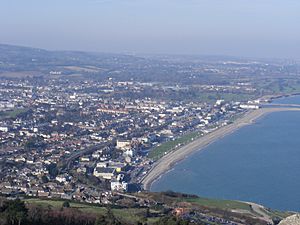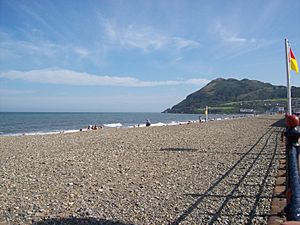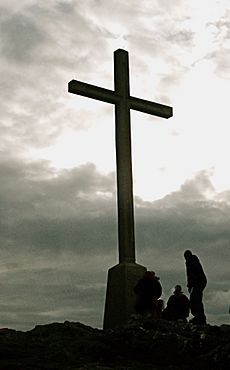Bray facts for kids
Quick facts for kids
Bray
Bré
|
||
|---|---|---|
|
Town
|
||

The town as seen from Bray Head
|
||
|
||
| Motto(s):
Féile agus Fáilte (Irish)
"Hospitality and Welcome" |
||
| Country | Ireland | |
| Province | Leinster | |
| County | County Wicklow | |
| Dáil Éireann | Wicklow | |
| EU Parliament | South | |
| Elevation | 18 m (59 ft) | |
| Population
(2011)
|
||
| • Rank | 9th | |
| • Urban | 26,852 | |
| • Rural | 5,020 | |
| Time zone | UTC+0 (WET) | |
| • Summer (DST) | UTC-1 (IST (WEST)) | |
| Irish Grid Reference | O264185 | |
Bray (which means hill in Irish, or Bré) is a lively town right on the coast in north County Wicklow, Ireland. Part of the town even stretches into County Dublin. It's located about 20 km (12 mi) south of Dublin city centre, on the east coast.
Bray is a busy place and a popular seaside resort. It has a population of 31,872 people, making it one of the largest towns in Ireland. Its beautiful location and closeness to Dublin make it a favourite spot for tourists and people visiting for the day.
Bray is also home to Ardmore Studios, where many Irish and international movies, TV shows, and adverts are made. The town has some light industries and shops, especially on its southern side. Getting to Dublin from Bray is easy, with trains, Dublin Bus services, and major motorways like the M11 and M50.
Contents
Bray: A Fun Seaside Town
What Does Bray Mean?
The name "Bray" or "Bré" means hill or rising ground. This might refer to how the town gently slopes up from the Dargle Bridge towards Vevay Hill and Bray Head.
A Look Back in Time
Long ago, in medieval times, Bray was on the southern edge of an area called the Pale. This was a coastal part of Ireland directly controlled by the English king from Dublin Castle. Further inland, Irish clans like the O'Toole and O'Byrne families were in charge.
Bray appears on an old map from 1598 by Abraham Ortelius, where it's called "Brey." For a long time, Bray was just a small village. But in the late 1700s, people from Dublin started moving to Bray. They loved its beautiful mountains and the chance to swim in the sea nearby.
How Bray Grew
A big change happened in 1854 when the railway line from Dublin reached Bray. This made the town grow quickly and become Ireland's biggest seaside resort! Many hotels and large houses were built near the seafront.
A railway businessman named William Dargan even built fancy Turkish baths in a Moorish style. These baths cost a lot of money back then! Bray continued to do well after Ireland became independent.
After the Second World War, many tourists from the United Kingdom came to Bray to enjoy holidays away from their homes. However, from the 1960s onwards, it became easier for people to travel abroad. This meant fewer people chose Bray for their main holiday. But even today, many day-trippers still visit Bray, especially in summer. The Summer Festival, with its fun rides, fireworks, and airshow, brings thousands of visitors in July and August.
In August 2012, thousands of people gathered on the seafront to welcome home Katie Taylor. She is a famous Olympic boxing champion from Bray.
Where is Bray Located?
Bray is located on the east coast, just south of County Dublin. To the north is Shankill in County Dublin, and to the south is Greystones, County Wicklow. The pretty village of Enniskerry is to the west, at the bottom of the Wicklow Mountains.
The Irish Sea gives Bray lovely views and mild weather all year. People enjoy sports like sailing, rowing, and swimming here. The beach and seafront Promenade are popular places for locals and visitors to meet and relax. The beach has been changed over the years to protect the town from the sea.
The River Dargle flows into the sea at the north end of Bray. It starts high up in the Wicklow Mountains, near Djouce. Bray Head is a large hill at the southern end of the famous Victorian Promenade. There are paths that lead to the top of Bray Head and along the sea cliffs. The rocks of Bray Head are a mix of greywacke and quartzite. A large concrete cross at the top of Bray Head is a well-known landmark and a popular spot for visitors. South and west of Bray, the Wicklow Mountains are Ireland's largest upland area, perfect for hiking and mountain biking.
Getting Around Bray
Bray has a good public transport system that connects it to Dublin in the north and County Wicklow and County Wexford in the south.
Trains to Bray
Bray is part of the DART train network. DART trains go north to Malahide and Howth and south to Greystones. The town is also on the main Iarnród Éireann rail line. This line goes north to Connolly Station in Dublin city centre, and then further to Drogheda and Dundalk. To the south, the train line goes through Arklow and Gorey before reaching Rosslare Europort.
Bray's railway station is named after Edward Daly, a leader of the 1916 Easter Rising. Bray Station first opened on 10 July 1854. On the eastern platform of the station, there's a mural showing important moments from local and national history from the 1850s to the 2000s. These are now being replaced by mosaics.
Buses in Bray
Five bus companies serve Bray: Dublin Bus, Bus Éireann, Finnegan's Bray, Aircoach, and St. Kevin's Bus Service to Glendalough. Dublin Bus is the biggest, with frequent services to and from Dublin city centre. They also have many services within North Wicklow and South Dublin. Dublin Bus also goes to places like Dún Laoghaire, Enniskerry, Greystones, Kilmacanogue, Kilcoole, and Newtownmountkennedy. Finnegan's Bray also offers a night bus service from Dublin. Aircoach runs an hourly service to and from Dublin Airport.
Driving to Bray
Bray is located along the M11 motorway. At its northern end, there's a connection to the M50 Dublin bypass.
Airports Near Bray
Bray has easy access to nearby airports. Dublin Airport can be reached using the M50 motorway. The AirCoach bus service also has two stops in Bray for trips to and from Dublin Airport. Newcastle Aerodrome is the closest private airfield, a short distance south of Bray.
Fun Things to Do in Bray
Bray is a well-known holiday spot with many hotels, guesthouses, shops, restaurants, and evening entertainment. The town also hosts several popular festivals.
In Bray, you can find two 18-hole golf courses, a tennis club, fishing spots, a sailing club, and horse riding. Other fun places include amusement arcades and the National Sealife Centre. Bray is known as the Gateway to Wicklow and is the oldest seaside town in Ireland. It has a beach of sand and shingle that is over 1.6 km (1 mi) long, with a wide promenade in front of it. Bray Head, which rises steeply 241 m (791 ft) from the coast, stands out and offers amazing views of the mountains and sea. The concrete cross at the top of Bray Head was put there in 1950 for a special holy year.
Bray is a great place for walkers. Its mile-long promenade stretches from the harbour, where you can see many mute swans, to the bottom of Bray Head. From there, a well-used path leads to the top of the hill. Another very popular walk is the 7 km (4.3 mi) Cliff Walk along Bray Head to Greystones.
The amusements on Bray Beach have been a big draw for day visitors from Dublin for many years. In January 2010, Bray was even named the "cleanest town in Ireland" in a survey!
Cool Places to Visit
There are many attractions all year round. You can walk along the Bray Promenade and feed the swans at the harbour. Or try the Cliff Walk from Bray around Bray Head Mountain to Greystones village. There's also the Sealife Aquarium and the beautiful Kilruddery House and Gardens. For adventure, both young and old can enjoy Squirrel’s Scramble in Kilruddery Gardens and Bray Adventures for all sorts of sea and land activities.
Exciting Festivals
- Saint Patrick's Day Festival: Bray hosts a big carnival and festival events to celebrate Saint Patrick's Day around 17 March each year. The Bray St. Patrick's Carnival and Parade is a five-day festival with carnival fun, parades, and live entertainment.
- Silent Film Festival: Bray has a yearly silent film festival, the Killruddery Film Festival, held in Killruddery Gardens.
- Bray Jazz Festival: This festival happens every year on the May bank holiday weekend. It features jazz and world music artists from Ireland and other countries.
- Bray Summerfest: The annual Bray Summerfest is a popular tourist event that lasts for six weeks in July and August. It has over 100 free entertainment events, including live music, markets, sports, carnivals, and family fun. Famous performers like Mundy and Mary Black have played here. In 2006, over 60,000 visitors came for the main festival weekend.
Fun Events
- Hell & Back event: This is an adventure race that takes place in Kilruddery Estates a few times a year. Thousands of people gather to run these challenging races.
- Cliff Run event: The 10 km (6.2 mi) Cliff Run from Bray to Greystones is an annual race along the coast around Bray Head Mountain. It's very popular with runners from all over Ireland.
Places to Eat and Drink
Bray has many pubs and restaurants. It's home to the first Porterhouse bar, which makes its own special ales, stouts, and beers. In 2010, the Lonely Planet Guide called the Harbour Bar in Bray the "Best Bar in the World"! The O'Toole family owned the bar for three generations, but the Duggan family bought it in 2013. The Duggans also run two places on the seafront, Katie Gallagher's and the Martello, both with restaurants. Many bars on Bray seafront have large outdoor areas, great for big crowds in the summer. Most of them also serve food. There are 22 places in Bray where you can get a drink, including six hotels.
There are also 12 restaurants that serve different kinds of food, like Chinese, Indian, Nepalese, and European. You can also find several cafes that serve breakfast, lunch, or snacks during the day. A McDonald's fast food restaurant is located on the ground floor of the Old Town Hall on Main Street.
Bray's Creative Side
Bray has a lively arts scene with many different types of art. There's a special arts centre, several galleries, places that host live music and performances, and various art groups in the community.
Art and Galleries
The Mermaid Arts Centre opened in 2002. It has a theatre with 250 seats for live music, plays, performances, and art-house movies. There's also a large gallery upstairs that shows modern visual art, and a studio area. You can find a cafe on the ground floor too.
The Signal Arts Centre was started in 1990. It provides gallery and studio space for local artists. It's run by volunteers and has a regular schedule of exhibitions by groups and individual artists. It's located on Albert Avenue near the Seafront.
The Bray Arts Group was formed in 1996 to push for an Arts Centre and to show off local talent in all kinds of art. Their monthly event at the Martello Hotel on Strand Road features music, literature, dance, and visual arts. The group also publishes a monthly journal online.
Movies Made in Bray
Bray is home to Ireland's oldest film studios, Ardmore Studios, which started in 1958. Famous movies like Excalibur, Braveheart, and Breakfast on Pluto were filmed here. The TV show Custer's Last Stand-up was also filmed in Bray. Part of Neil Jordan's film Byzantium was shot in the Bray Head Inn.
Currently, the Mermaid Arts Centre is the only place to watch movies in Bray. The main cinema on Quinnsboro Road closed down some years ago. There are plans to build a new cinema and shopping centre in Bray town centre.
Theatre and Shows
Bray has several theatre groups, including the Square One Theatre Group and Bray Arts. The main place for shows is the Mermaid Arts Centre, along with some smaller halls.
Books and Writers
Many famous authors have lived in Bray, including James Joyce, Sir Arthur Conan Doyle, and Neil Jordan. There are also writing groups like Abraxas. Cafe Literario on Albert Walk is a popular spot for people who love books in Bray. For a more formal setting, there's Bray Library on Eglinton Road, which is a Carnegie Library built in 1910.
Music and Dance
Music has a strong tradition in Bray, with regular music sessions in pubs like the Hibernian, the Harbour Bar, and the Martello. You can learn many types of music at the School of Music, supported by the Everest Center. Bray also has several choirs, including the Bray Community Choir, the Bray Choral Society, Bray Gospel Choir, and the Bray Youth Choir. Dance is also becoming more popular, with modern dance classes starting in schools in Bray, including the Bray School of Dance.
Bray's Twin Towns
Bray has town twinning agreements with:
- Bègles, France
- Dublin, California
- Würzburg, Germany
Gallery
-
St. Patrick's Day 2008
-
Bray from Bray Head
Images for kids
See also
 In Spanish: Bray para niños
In Spanish: Bray para niños



















